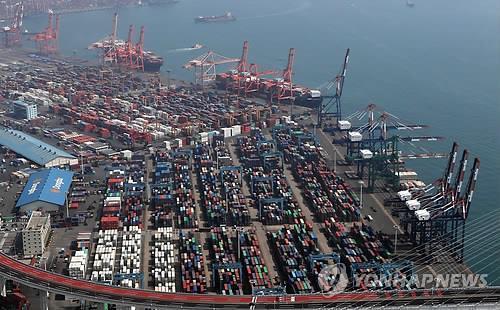Korea will pump an additional 21 trillion won ($17.4 billion) of fiscal stimulus into the economy until March to combat sagging exports and revitalize growth, the government said Wednesday.
The Ministry of Strategy and Finance said that public spending in the January-March period would rise by 6 trillion won to 144 trillion won, with 2 trillion won of the amount to come from the central government. The government’s total budget for 2016 stays unchanged at 386.4 trillion won.
 |
Containers are seen stacked up at Busan Port. (Yonhap) |
The stimulus package also features an additional 15.5 trillion won of policy loans to be extended to local businesses, extension of tax relief for new car owners and a combined 5 trillion won worth of investment in alternative energy projects by state-owned corporations.
“We expect the increased frontloading (of fiscal spending) to add a 0.2 percentage point to growth (on a quarter-on-quarter basis,)” Deputy Finance Minister Lee Chan-woo told reporters. “Through these measures, we hope the growth for the whole year to approach the government’s projection of 3.1 percent.”
Growth in Asia’s fourth-largest economy slowed to 2.6 percent in 2015, the slowest in more than three years, as exports are fast losing steam amid a cooling demand in China and other emerging markets and plunging oil prices. Exports account for nearly 50 percent of the country’s gross domestic product and China is Korea’s top export market.
With no turnaround in sight in global demand, economists say that Korea will see economic expansion below 3 percent in 2016, lower than the government’s forecast of 3.1 percent and the Bank of Korea’s 3.0 percent.
Further darkening the mood, data released Monday showed an 18.5 percent drop in shipments from Korea in January, the steepest decline in more than six years. It was the 13th straight month that exports fell from the corresponding period a year ago.
The stimulus plan unveiled Wednesday focuses on spurring domestic investment and consumption to prop up the export-driven economy.
The tax program envisions individual consumption taxes on passenger cars to again go down to 3.5 percent from 5 percent, after a temporary 1.5 percentage point cut lapsed at the end of December. The extension is for six months till the end of June.
By Lee Sun-young (
milaya@heraldcorp.com)








![[Today’s K-pop] Blackpink’s Jennie, Lisa invited to Coachella as solo acts](http://res.heraldm.com/phpwas/restmb_idxmake.php?idx=644&simg=/content/image/2024/11/21/20241121050099_0.jpg)